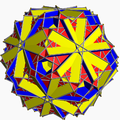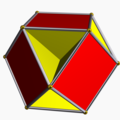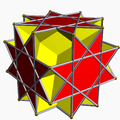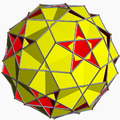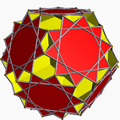List of convex omnitruncated polyhedra
There are three convex forms. These forms can be seen as red faces of one regular polyhedron, yellow or green faces of the dual polyhedron, and blue faces at the truncated vertices of the quasiregular polyhedron.
| Wythoff symbol p q r | | Omnitruncated polyhedron | Regular/quasiregular polyhedra |
|---|---|---|
| 3 3 2 | |  Truncated octahedron |    Tetrahedron/Octahedron/Tetrahedron |
| 4 3 2 | |  Truncated cuboctahedron |   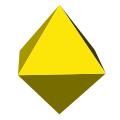 Cube/Cuboctahedron/Octahedron |
| 5 3 2 | |  Truncated icosidodecahedron |    Dodecahedron/Icosidodecahedron/Icosahedron |


